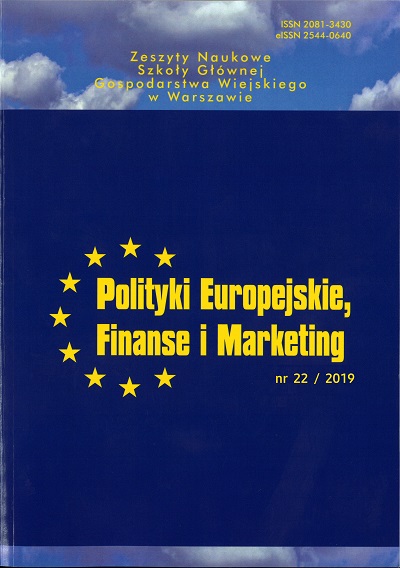Main Article Content
The purpose of the article is to substantiate the emergence of new – and the development of existing – factors and segmentation criteria for meeting consumer needs and increasing the efficiency of marketing activities for Ukrainian enterprises under modern market conditions. The object of the research is to analyze the process of development and any increases in the effectiveness of marketing segmentation. The subject of research is the theoretical, methodical and practical provisions of the formation of targeted marketing segmentation for the markets of Ukrainian enterprises. The goal of the research is to evaluate the direction and type of market segmentation that determines future target segments for enterprises and their share of existing markets. We present the characteristics of enterprises that work on market relations for the production and sale of computer devices that provide network connections. Our method was to estimate the direction and type of market segmentation in order to determine the prospective segments for such enterprises and their share of the existing market. In order to evaluate the attractiveness of target segments for Ukrainian enterprises, a survey was conducted to validate customer reactions. The analyzed variables included: the length of time a person uses his/her computer device; the reasons for possible changes and important settings when choosing a computer device; the timeframe for buying a computer device. The results of the questionnaire are separated by gender, social and geographic factors, as well as by family composition and age of respondents, taking into account the stages of their life cycle, as well as their educational level and professions – for three enterprises. Particular attention was paid to the psychographic factors of occupation and social class. The questionnaire also contained a self-assessment section on the psychological qualities of the consumer and on their psychography, which we analyzed. The hypotheses presented by individual factors and the consumer segment, separated by the results of the survey, and the analysis of the respondents' answers, are presented. Confirmation of the hypotheses and isolation of the consumer segment are given.
Article Details
Anderson, E. W., Fornell, C., & Mazvacheryl, S. K. (2004). Customer satisfaction and shareholder value.Journal of Marketing, 68(4), 172-185. Retrieved from http://dx.doi.org/10.1509/jmkg.68.4.172.42723. (Crossref)
Baron, S. and Harris, K. (2010). Toward an Understanding of Customer Perspectives on Experiences. Journal of Services Marketing, 24(7), pp. 518-531. (Crossref)
Bludova T.V., Tokar V.V. (2013). Modeling of innovation and investment activity in the context of economic security of the enterprise // Effective Economics. - 2013. - № 2. - [Electronic resource]. - Access mode: http://nbuv.gov.ua/UJRN/efek_2013_2_58 (In Ukrainian).
Cliff K (2009) A formative index of segment attractiveness: optimising segment selection for tourism destinations. Ph.D. thesis, School of Management and Marketing, Faculty of Commerce, University of Wollongong.
Dolnicar S, Leisch F (2010) Evaluation of structure and reproducibility of cluster solutions using the bootstrap. Mark Lett 21:83-101. (Crossref)
Dolnicar S, Leisch F (2017) Using segment level stability to select target segments in data-driven market segmentation studies. Mark Lett 28(3):423-436. (Crossref)
Kotler, P. and Keller, L.G. (2013). Marketing Management, Prague: Grada Publishing (in Czech).
Kourdi, J. (2011). Marketing Century: How Marketing Drives Business and Shapes Society, Chichester: John Wiley & Sons. (Crossref)
Kowalkowski, CH. (2011). Dynamics of Value Propositions: Insights from Service-Dominant Logic, European Journal of Marketing, Vol.45, No:1/2, pp. 277-294. (Crossref)
Kumar, N. (2008). Marketing as Strategy Leading to Successs, Prague: Grada Publishing (in Czech).
McDonald M, Dunbar I (2004). Market Segmentation: How to Do It, How to Profit from It.Elsevier ButterworthHeinemann. Oxford.
T. Bludova (2005). Probability Theory: Educ. guide Lviv. NBU National Bank, 2005- 319 p. (In Ukrainian).
Wallenburg, C. M. and Lukassen, P. (2011). Proactive Improvement of Logistics Service Providers as Driver of Customer Loyalty, European Journal of Marketing, Vol. 45, No: 3, pp. 438-454. (Crossref)
Wiedmann, K.P., Hennigs, N., Pankalla, L., Kassubek, M., Seegebarth, B. and Reeh, M.O. (2010). Online Distribution of Pharmaceuticals: Investigating Relations of Consumers' Value Perception, Online Shopping Attitudes and Behaviour in a Epharmacy Context, Journal of Customer Behaviour, Vol. 9, No. 2, pp. 175-199. (Crossref)
Wood SN (2006) Generalized additive models: an introduction with R. Chapman and Hall/CRC, Boca Raton.
Downloads
- Jacek Strojny, Wiesław Musiał, Obszary wiejskie w systemie ekonomiczno-społecznym państw Unii Europejskiej , Zeszyty Naukowe SGGW, Polityki Europejskie, Finanse i Marketing: Nr 22(71) (2019)
Możesz również Rozpocznij zaawansowane wyszukiwanie podobieństw dla tego artykułu.
- Nadiia Davydenko, Alina Buriak, Natalia Wasilewska, Mirosław Wasilewski, Zarządzanie ryzykiem rozwijania potencjału finansowego podmiotów gospodarczych , Zeszyty Naukowe SGGW, Polityki Europejskie, Finanse i Marketing: Nr 29(78) (2023)
- Nadiia Davydenko, Ivan Olifer, Natalia Wasilewska, Mirosław Wasilewski, Szara strefa i jej wpływ na potencjał finansowy kraju , Zeszyty Naukowe SGGW, Polityki Europejskie, Finanse i Marketing: Nr 24(73) (2020)
- Nadia Davidenko, Natalia Wasilewska, Zapewnienie równowagi finansowej przedsiębiorstw rolnych na Ukrainie , Zeszyty Naukowe SGGW, Polityki Europejskie, Finanse i Marketing: Nr 26(75) (2021)
- Natalia Wasilewska, Nadiia Davydenko, FINANCIAL MANAGEMENT MODELING FOR ENTERPRISES , Zeszyty Naukowe SGGW, Polityki Europejskie, Finanse i Marketing: Nr 19(68) (2018)
- Natalia Wasilewska, Nadiia Davydenko, Assessment of the Credit Historyod Enterprises , Zeszyty Naukowe SGGW, Polityki Europejskie, Finanse i Marketing: Nr 18(67) (2017)
- Natalia Wasilewska, Tetiana Kaminska, PRECONDITIONS OF LAND RELATIONS DEVELOPMENT: ECONOMIC, LEGAL AND INSTITUTIONAL , Zeszyty Naukowe SGGW, Polityki Europejskie, Finanse i Marketing: Nr 20(69) (2018)

Utwór dostępny jest na licencji Creative Commons Uznanie autorstwa – Użycie niekomercyjne 4.0 Międzynarodowe.





